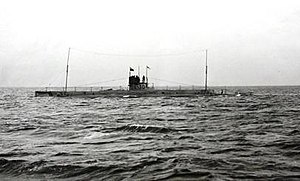HMS E30
 HMS E30
| |
| History | |
|---|---|
| Name | HMS E30 |
| Builder | Armstrong Whitworth, Newcastle upon Tyne |
| Laid down | 29 June 1914 |
| Commissioned | November 1915 |
| Fate | Sunk by mine, 22 November 1916 |
| General characteristics | |
| Class and type | E class submarine |
| Displacement |
|
| Length | 181 ft (55 m) |
| Beam | 15 ft (4.6 m) |
| Propulsion |
|
| Speed |
|
| Range |
|
| Complement | 30 |
| Armament |
|
HMS E30 was a British E class submarine built by Armstrong Whitworth, Newcastle upon Tyne. She was laid down on 29 June 1914 and was commissioned in November 1915.
HMS E30 was mined off Orfordness, Suffolk in the North Sea on 22 December 1916. There were no survivors.
Design
Like all post-E8 British E-class submarines, E30 had a displacement of 622 tonnes (686 short tons) at the surface and 807 tonnes (890 short tons) while submerged. It had a total length of 180 feet (55 m)[1] and a beam length of 22 feet 8.5 inches (6.922 m). It contained two diesel engines each providing a power of 1,600 horsepower (1,200 kW) and two electric motors each providing 840 horsepower (630 kW) power.[2] Its complement was thirty-one crew members.[1]
The submarine had a maximum surface speed of 16 knots (30 km/h; 18 mph) and a submerged speed of 10 knots (19 km/h; 12 mph). British E-class submarines had fuel capacities of 50 tonnes (55 short tons) of diesel and ranges of 3,255 miles (5,238 km; 2,829 nmi) when travelling at 10 knots (19 km/h; 12 mph).[1] E30 was capable of operating submerged for five hours when travelling at 5 knots (9.3 km/h; 5.8 mph). It was fitted with a 12 pounds (5.4 kg) quick-firing gun gun (12 pounder), five 18 inches (460 mm) torpedo tubes, and one spare torpedo tube. Its torpedo tubes were fitted at the front and the aft; unlike pre-E9 submarines, the two midship section torpedo tubes were not included.[1]
E-Class submarines contained wireless systems with 1 kilowatt (1.3 hp) power ratings; in some submarines, these were later upgraded to 3 kilowatts (4.0 hp) systems by removing a midship torpedo tube. Its claimed highest dive depth was 100 feet (30 m) although it was capable of reaching depths of below 200 feet (61 m). Some submarines contained Fessenden oscillator systems.[1]
References
- ^ a b c d e Innes McCartney; Tony Bryan (20 February 2013). British Submarines of World War I. Osprey Publishing. pp. 11–12. ISBN 978-1-4728-0035-0.
- ^ "E Class". Chatham Submarines. Retrieved 20 August 2015.
Bibliography
- Hutchinson, Robert (2001). Jane's Submarines: War Beneath the Waves from 1776 to the Present Day. London: HarperCollins. ISBN 978-0-00-710558-8. OCLC 53783010.
External links
